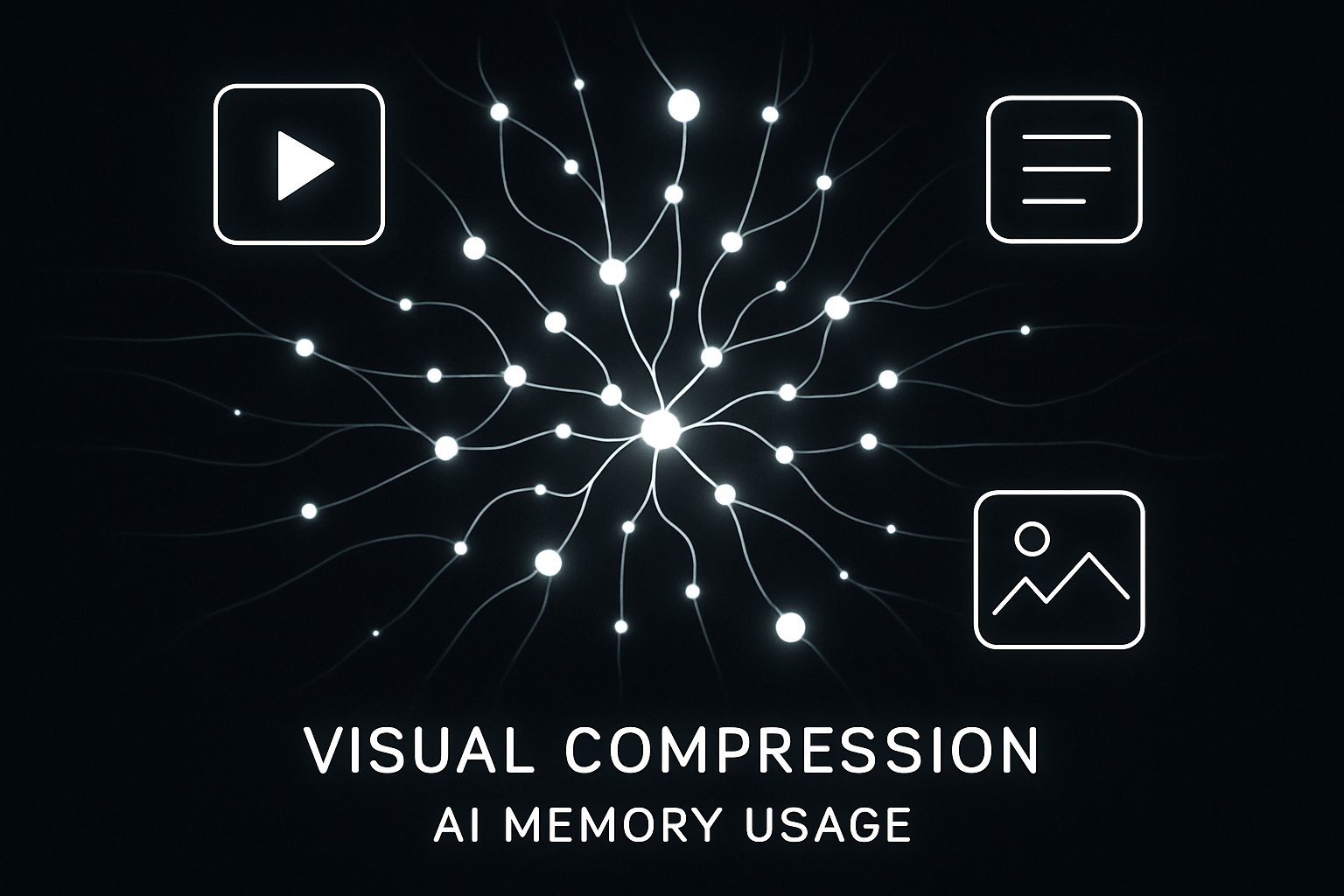
AI CERTS
4 hours ago
DeepSeek Visual Compression Spurs AI Memory Optimization
Analysts call the method timely. Transformer models struggle with swelling prompts and the dreaded "context rot" where earlier information fades. DeepSeek counters that decay through compressed snapshots. Moreover, the project integrates with vLLM, ensuring production throughput remains high. The resulting architecture sparks interest from vendors seeking efficient retrieval-augmented generation pipelines.

DeepSeek Visual Memory Breakthrough
DeepSeek-OCR converts long pages into high-resolution images. A visual encoder then produces OCR visual tokens. These embeddings replace hundreds of text tokens. Therefore, downstream decoders attend to fewer elements while reconstructing near-original wording. Authors report 97% precision at sub-10× compression. Nevertheless, accuracy drops sharply beyond 20×, reminding adopters to test thresholds carefully.
Community repositories already host experimental GUIs. Additionally, Tom’s Hardware notes early forks boasting multimodal layouts. GitHub stars surpassed ten thousand within days, underscoring developer excitement. These trends highlight growing demand for practical AI memory optimization techniques.
These adoption signals confirm market curiosity. However, rigorous benchmarking will decide long-term traction.
Real Cost And Throughput
Operational metrics shape enterprise decisions. DeepSeek claims training throughput nearing 200k pages daily on one A100-40G GPU. Meanwhile, vLLM examples cite 2,500 tokens per second during inference. Such numbers suggest notable token efficiency. Furthermore, compression ratios between 7× and 20× promise tangible cloud savings, although actual bills depend on workload mix.
- OmniDocBench lead: 100 vision tokens outran 256-token baselines.
- Native modes: Tiny 64, Small 100, Base 256, Large 400 tokens.
- Production pipelines tested PDF concurrency without memory thrash.
Consequently, infrastructure teams eye resource consolidation. Yet hardware complexity remains. Image encoding demands high-resolution pipelines and bespoke attention windows. Transitioning requires engineering discipline.
The figures illustrate headline gains. In contrast, hidden integration costs still merit attention.
Core Compression Mechanics Explained
The visual encoder blends SAM-style window attention with CLIP-like global views. Additionally, a 16× convolution downsamples features aggressively. These layers emit compact embeddings, the celebrated OCR visual tokens. Subsequently, a MoE decoder restores text, engaging specialized experts per linguistic feature. This modular decoder curbs parameter bloat while sustaining fidelity.
Designers position the compressed embeddings as a context rot solution. By freezing historical exchanges into images, chat agents recall earlier turns without repeated re-tokenization. Therefore, memory windows expand dramatically. Moreover, fewer tokens mean lighter self-attention matrices, unlocking quadratic savings.
These architectural choices underpin observed gains. Nevertheless, edge cases like handwriting or complex scripts may challenge robustness.
Governance And Compliance Challenges
Performance alone never seals a deal. Wired reminds readers that earlier DeepSeek models provoked regulatory scrutiny. Governance experts warn that compressed representations can conceal harmful content, complicating audits. Furthermore, export control uncertainties linger. Enterprises handling sensitive data must ensure the context rot solution aligns with local rules.
Reuters reported several government bans on DeepSeek deployments. Consequently, compliance teams demand explainability and red-team testing. Professionals can enhance their expertise with the AI Engineer™ certification, gaining skills to evaluate such models responsibly.
These governance hurdles could slow adoption. Nevertheless, transparent policies and third-party audits may ease concerns.
Major Benefits For Enterprises
Compression delivers multiple dividends. Firstly, fewer tokens lower API bills. Secondly, slimmer contexts accelerate inference, improving user latency. Thirdly, reduced compute drives carbon footprint reduction, a rising boardroom metric. Moreover, longer persistent history elevates user experience for legal research, customer support, and knowledge management.
Early adopters highlight collaborative drafting. Long briefs convert into 100-token images, keeping entire documents within prompt windows. Meanwhile, summarization agents reference original paragraphs without hitting length caps. Those gains reflect strong token efficiency.
These benefits resonate across sectors. However, stakeholders must balance accuracy against compression ratios.
Cost And Throughput
Finance leaders crave clear numbers. DeepSeek’s paper omits dollar comparisons, yet relative metrics help estimate savings. Suppose 20-page contracts tokenize to 10,000 tokens. Compression at 10× yields 1,000 vision tokens. Therefore, pay-per-token pricing could drop by 90%. Additionally, lower GPU memory reduces cluster size, magnifying savings and enabling further carbon footprint reduction.
Consequently, procurement teams prepare pilots with metered billing. In contrast, teams lacking high-resolution encoders may see offsetting costs. Balanced scoring remains essential.
These calculations underscore financial promise. The next section probes outstanding risks.
Key Risks And Caveats
No technology is flawless. Accuracy dips to 60% at 20× compression threaten data integrity. Additionally, cascading errors can poison downstream training corpora if unchecked reconstruction feeds future models. Moreover, plain narrative text may compress less efficiently than tabular layouts.
Hardware pipelines demand GPU bandwidth. Therefore, small startups might struggle to finance the necessary hardware, even with token efficiency gains. Furthermore, the governance issues mentioned earlier remain unresolved.
These challenges highlight critical gaps. However, practical mitigation strategies can narrow exposure.
Practical Next Steps Forward
Technical leaders should benchmark DeepSeek-OCR against domain data. Additionally, they can vary compression ratios to find acceptable accuracy floors. Meanwhile, independent labs should publish transparent evaluations covering multilingual content. Furthermore, cost studies converting token savings to dollar and CO₂ numbers would clarify carbon footprint reduction claims.
Subsequently, procurement teams can draft guardrails. Including human verification for reconstructed text helps maintain quality. Integration with RAG pipelines will require careful orchestration to avoid cache misses.
These steps offer a roadmap. Consequently, organizations can adopt visual compression with confidence.
Overall, DeepSeek-OCR pushes AI memory optimization into production conversations. Its compressed embeddings address scaling pain, yet diligence remains essential.
Conclusion And Outlook
DeepSeek’s vision-text compression arrives when context costs strain budgets. The approach demonstrates strong token efficiency, meaningful carbon footprint reduction, and a promising context rot solution. However, accuracy trade-offs, governance hurdles, and hardware demands persist. Consequently, cautious pilots, thorough audits, and clear ROI metrics will determine success. Nevertheless, the concept signals a future where AI memory optimization techniques redefine prompt engineering. Professionals eager to lead this wave should explore the linked certification and stay engaged with emerging benchmarks.
Adopt, measure, and iterate—your next competitive edge may hinge on compressed memory.



